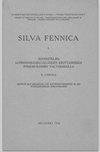An original method for tree species classification using multitemporal multispectral and hyperspectral satellite data
IF 1.7
3区 农林科学
Q2 FORESTRY
引用次数: 8
Abstract
This study proposes an original method for tree species classification by satellite remote sensing. The method uses multitemporal multispectral (Landsat OLI) and hyperspectral (Resurs-P) data acquired from determined vegetation periods. The method is based on an original database of spectral features taking into account seasonal variations of tree species spectra. Changes in the spectral signatures of forest classes are analyzed and new spectral–temporal features are created for the classification. Study sites are located in the Czech Republic and northwest (NW) Russia. The differences in spectral reflectance between tree species are shown as statistically significant in the sub-seasons of spring, first half of summer, and main autumn for both study sites. Most of the errors are related to the classification of deciduous species and misclassification of birch as pine (NW Russia site), pine as mixture of pine and spruce, and pine as mixture of spruce and beech (Czech site). Forest species are mapped with accuracy as high as 80% (NW Russia site) and 81% (Czech site). The classification using multitemporal multispectral data has a kappa coefficient 1.7 times higher than does that of classification using a single multispectral image and 1.3 times greater than that of the classification using single hyperspectral images. Potentially, classification accuracy can be improved by the method when applying multitemporal satellite hyperspectral data, such as in using new, near-future products EnMap and/or HyspIRI with high revisit time.基于多时相多光谱和高光谱卫星数据的树种分类新方法
本研究提出了一种新颖的卫星遥感树种分类方法。该方法使用从确定的植被期获得的多时相多光谱(Landsat OLI)和高光谱(reres - p)数据。该方法基于原始的光谱特征数据库,考虑了树种光谱的季节变化。分析了森林分类光谱特征的变化,并为分类创建了新的光谱时间特征。研究地点位于捷克共和国和西北(西北)俄罗斯。不同树种间的光谱反射率在春季、夏季上半季和秋季主要季节的差异均有统计学意义。大部分的错误与落叶松种的分类和将桦木误分类为松(俄罗斯西北部样地)、松为松和云杉的混交种、松为云杉和山毛榉的混交种(捷克样地)有关。森林物种的定位精度分别高达80%(俄罗斯西北部)和81%(捷克)。多时相多光谱数据分类的kappa系数比单幅多光谱图像分类高1.7倍,比单幅高光谱图像分类高1.3倍。当应用多时相卫星高光谱数据时,例如使用具有高重访时间的新产品EnMap和/或HyspIRI,该方法可能会提高分类精度。
本文章由计算机程序翻译,如有差异,请以英文原文为准。
求助全文
约1分钟内获得全文
求助全文
来源期刊

Silva Fennica
农林科学-林学
CiteScore
3.50
自引率
11.10%
发文量
21
审稿时长
3 months
期刊介绍:
Silva Fennica publishes significant new knowledge on forest sciences. The scope covers research on forestry and forest ecosystems. Silva Fennica aims to increase understanding on forest ecosystems, and sustainable use and conservation of forest resources. Use of forest resources includes all aspects of forestry containing biomass-based and non-timber products, economic and social factors etc.
 求助内容:
求助内容: 应助结果提醒方式:
应助结果提醒方式:


